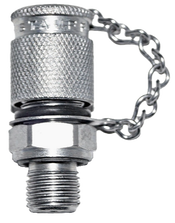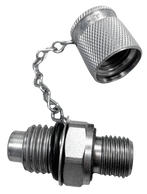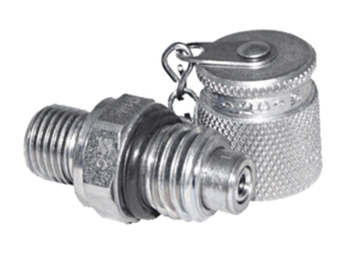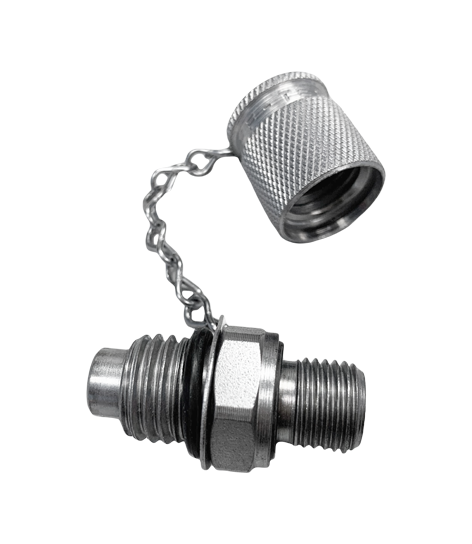|
|
Stauff test couplings are technologically planned couplings to fit into suitable positions of a hydraulic system during the production phase of a machine. On the other hand, it can also be included in a later stage during retrofitting or upgrading of the system. Stauff test couplings are designed to ease the work of maintenance workers and machine fabricators to securely and connect digital and analogue metrics and display mechanisms for periodic testing or to serve as a long-term tool for monitoring pressure, temperature level, and many more factors. The maximum working pressure for Stauff test couplings is 630 bars and can be connected using the metric thread and inches thread. |
Material Specification |
|
Connection Type |
|
Temperature Range |
|
Working Pressure |
|
1. How are Stauff Test Couplings installed?
|
While using a test coupling connection, there’s no need for any connecting tools to attach the couplings to the system. A test coupling connection can be done while the system is operating under maximum system pressure of 630 bars or 9135 PSI. However, determining the working pressure for each coupling is based on the system used for the operation. Stauff test couplings serve as a tool for regulating and monitoring pressure. The test couplings connection thread is available in two types – Inches thread and Metric thread.
|
Stauff test couplings are made with the connection thread following the ISO 15171-2 standard. This standard states the test process, performance expectations, and dimensions for diagnostic couplings designed with the M16 x 2 connection which can be attached to the system during operation under a maximum pressure of 400 bar. Test couplings are suitable for use in low and high pressure applications.
Test couplings are shut off using a threaded nipple with automated means whilst the system is under operation. The couplings are not creased after fully installing the inner valve parts and seals which contributes to the right and unfailing performance of the couplings when operating under permanent load. Another edge of test couplings over others is the vibration protection characteristics that help the system avoid automatic detachment of the plastic cap or protective metal that often occurs during system vibration.
Test couplings are shut off using a threaded nipple with automated means whilst the system is under operation. The couplings are not creased after fully installing the inner valve parts and seals which contributes to the right and unfailing performance of the couplings when operating under permanent load. Another edge of test couplings over others is the vibration protection characteristics that help the system avoid automatic detachment of the plastic cap or protective metal that often occurs during system vibration.
2. What are Stauff Test Couplings made of?
Stauff test couplings are made from stainless steel SS316 and carbon steel. Carbon steel is a material that comprises various combinations of other elements. Carbon steel contains two elements which are iron and carbon. The table below displays the chemical composition of carbon steel:
|
For Stauff test couplings, the surface is coated with zinc-nickel to enhance the surface protection against wear and corrosion during operation. The available grade is Steel zinc/nickel-plated – W3.
|
Stainless steel is a type of austenitic material that is recorded to have a great level of corrosion resistance. Stainless steel contains a percentage of chromium which contributes to the resistance. There are different types of stainless steel materials such as 304, 316, 316L, etc. SS316 is the type that contains molybdenum which helps increase the strength and corrosion resistance feature of the material. The table below shows the chemical composition of the SS316:
|
3. What are the advantages of using Stauff Test Couplings?
|
The check valve inserted into the Stauff test coupling gets unlocked only after the installation of adapters or test hoses alongside display and measuring mechanisms that comprise the full product package. This connection gives a secure and trustable sealing of the installation without any leakage threat of fluids getting wasted during operation. Here are some advantages of Stauff test couplings:
|
4. What are the factors to guide when ordering Stauff Test Coupling?
The Stauff test couplings are available in three different sealing types which should be noted before ordering the package. They are NBR, EPDM, and FKM. The table below shows more information about sealing types:
Stauff Test couplings are used for mineral oil-based fluids and hydraulic oils. It is recommended that a compatibility test with the seal type should be carried out. The total Stauff test coupling is packaged with a hexagonal protection cap made from plastic or steel material.
The table below shows the Stauff test coupling with ball check order option:
The table below shows the Stauff test coupling with ball check order option:
Stauff Series |
Types |
Connections |
SMK-20 Type K |
Test Coupling |
24⁰ Taper / O-ring (DKO) |
SMK-20 Type G |
Test Coupling |
Straight 24⁰ Fitting |
SMK-20 JIC Type G |
Test Coupling |
Straight 37⁰ JIC Connection |
SMK-20 JIC Type K |
Test Coupling |
37⁰ JIC Connection |
SMK-20 Type ORFS |
Test Coupling |
ORFS Connection |
SGV-JIC Type FM |
Swivel Run Tee |
37⁰ JIC Connection |
SAD-20 |
Test Adaptor |
- |
SSK-20 |
Bulkhead |
- |
SMA-20 SMD-20 |
Gauge Adaptor |
- |
The table below shows the Stauff Test Coupling with Piston Valve order option:
Stauff Series |
Types |
Connections |
SKK-20 |
Test Coupling |
Male Threaded Stud |
SMK-20 Type G |
Test Coupling |
Straight 24⁰ Fitting |
SKK-20 Type K |
Test Coupling |
24⁰ Taper / O-ring (DKO) |
SMK-15 |
Test Coupling |
Male Threaded Stud |
SMK-15 Type G |
Swivel Run Tee |
Straight 24⁰ Fitting |
SMK-15 Type K |
Test Coupling |
24⁰ Taper / O-ring (DKO) |
SSK-15 |
Bulkhead |
37⁰ JIC Connection |
SAD-15 |
Swivel Run Tee |
- |
SMA-15 SMD-15 |
Gauge Adaptor |
- |
TEST COUPLINGS catalogue









